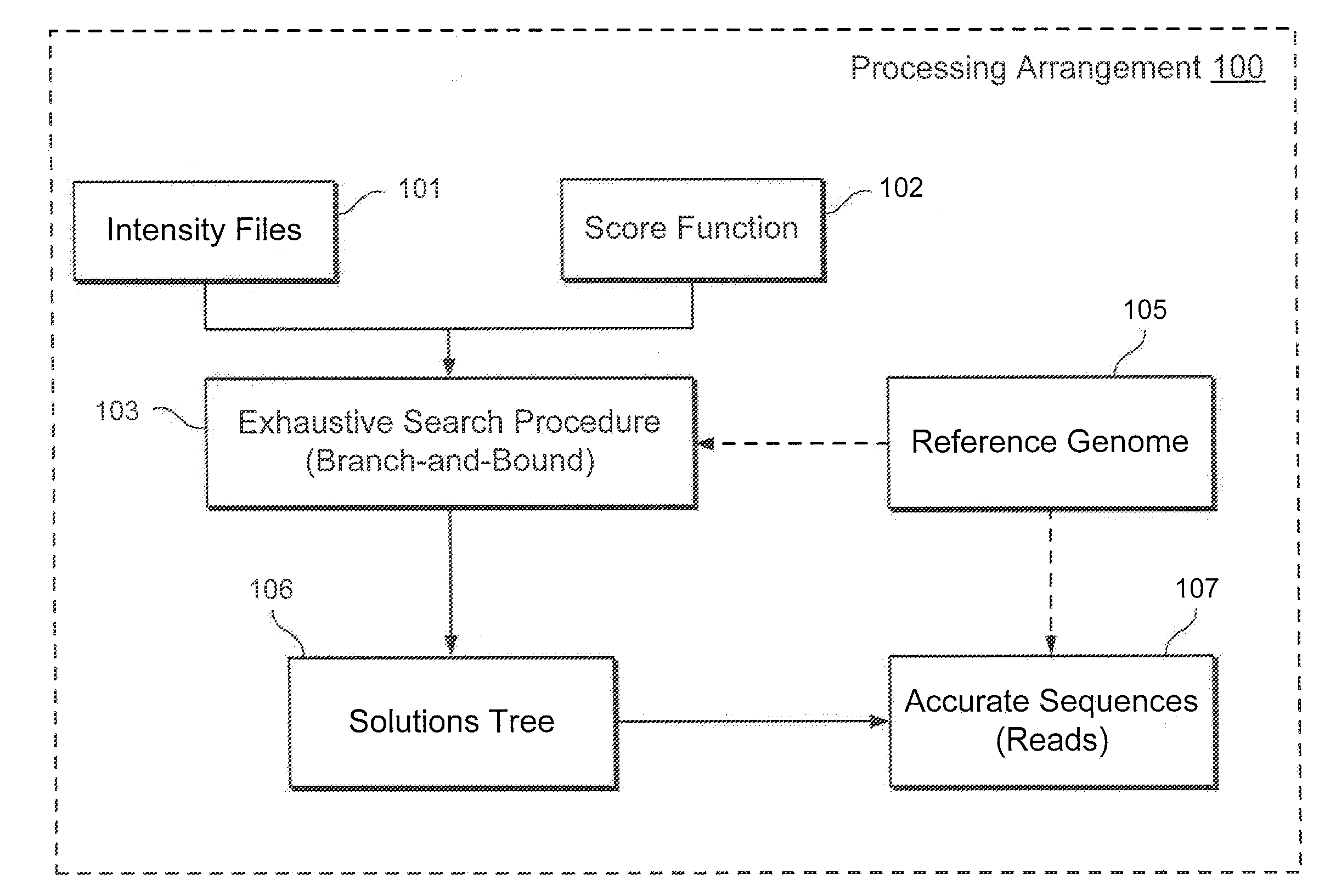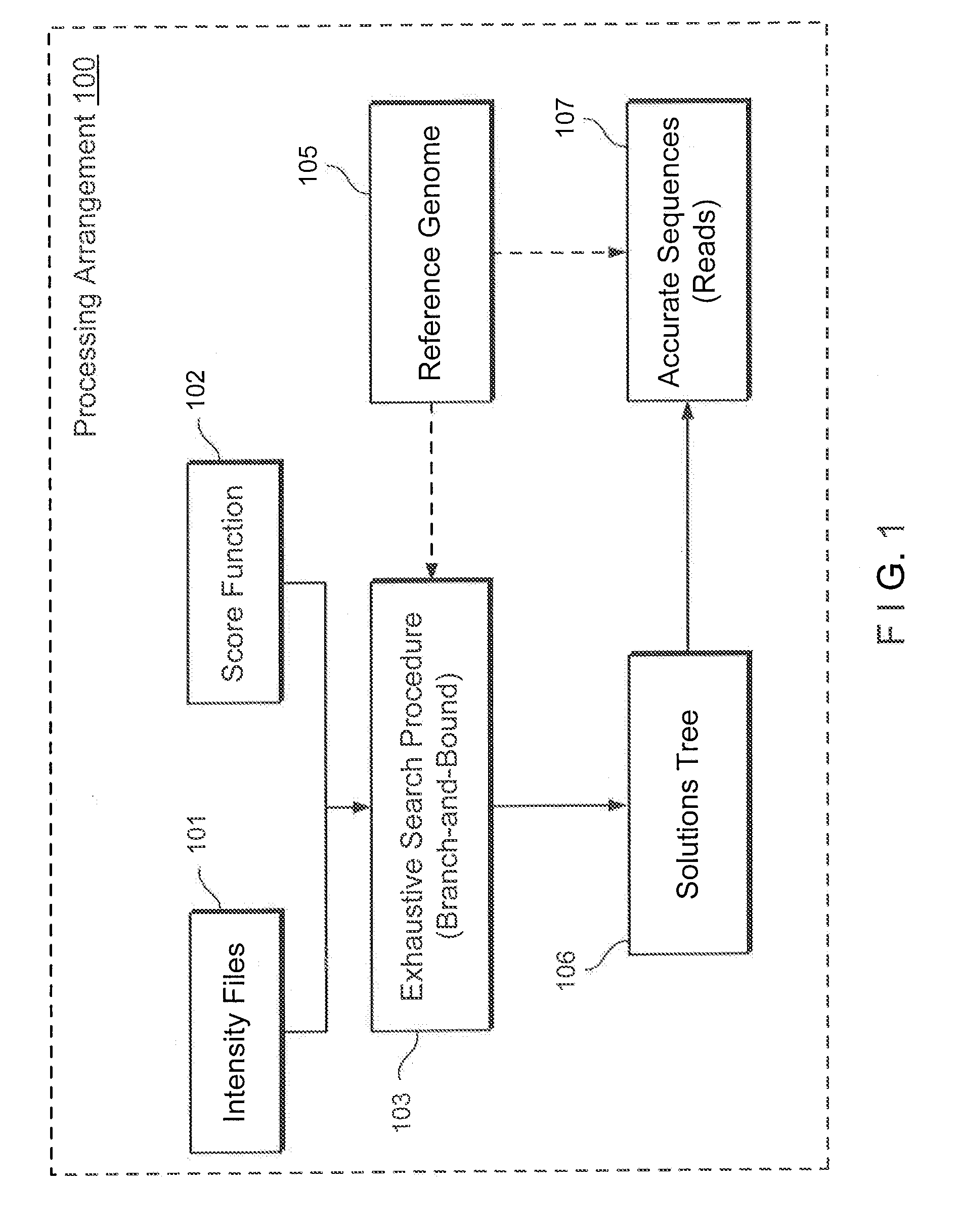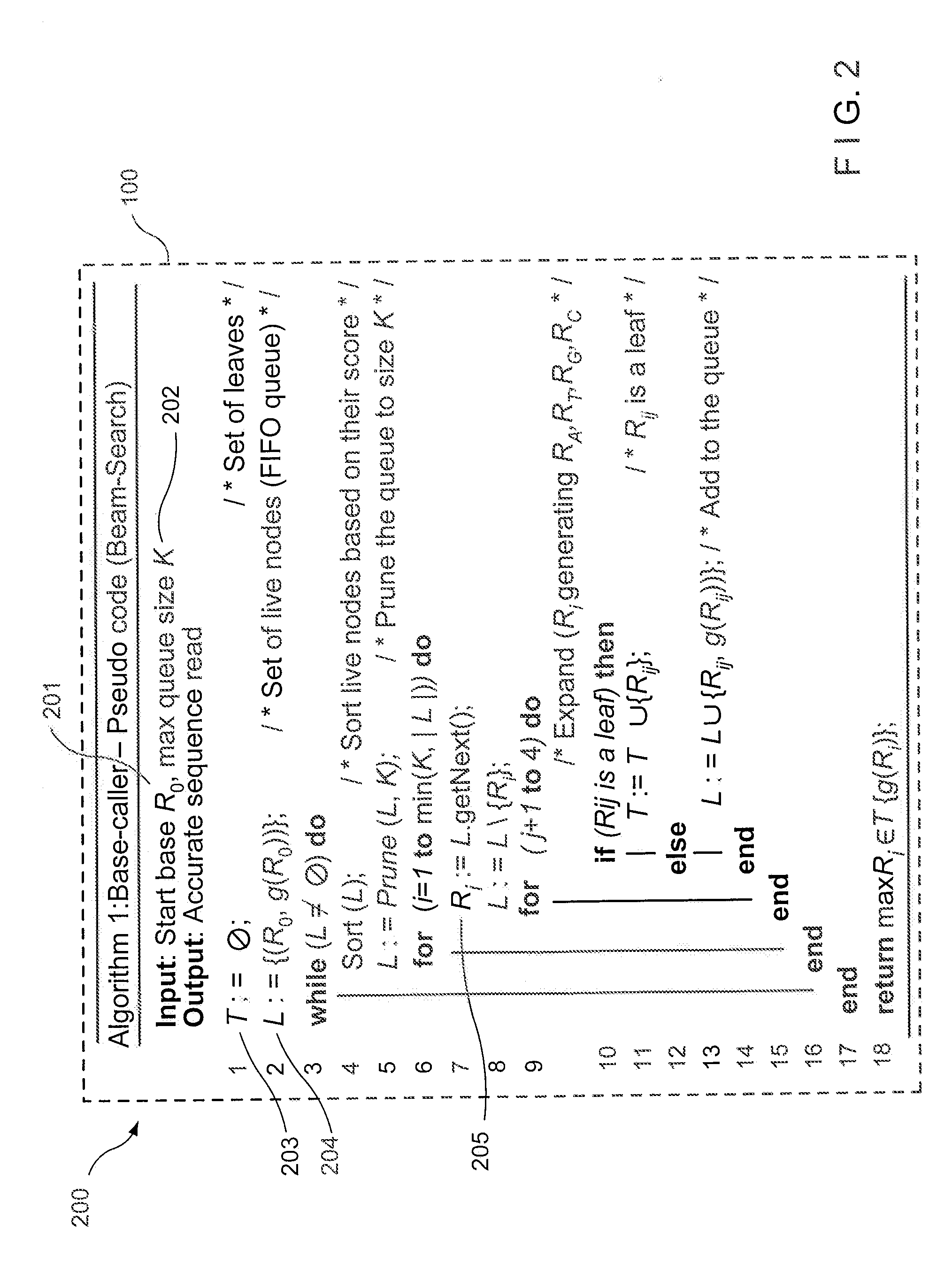If the reads from a sequencing platform are shorter than certain thresholds, its utility in many biomedical applications can be limited even though the platform can provide a cost and / or
throughput advantage.
Previously available sequencing platforms likely fall short of a scalable haplotypic whole-
genome technology for which there appears to be a need.
For example, such heretofore available technologies usually can generate relatively short genotypic reads (e.g., from about 35 bps to about 300 bps, without haplotypic and locational context), that can be corrupted by errors such as low-quality base-calls and / or compression of homopolymeric runs, and can frequently lack long-range
contextual information aside from mate-pair data.
These shortcomings can affect the yield and / or speed of the resulting technology and have a debilitating effect on the complexity of the base-calling, alignment and / or
assembly algorithms and / or procedures.
However, despite such improvements, at least two limitations can remain.
However, while some of these proposed methods may provide lower latency and / or higher
throughput at a relatively lower cost, such proposed methods may not have improved the read lengths nor provided for any
contextual information.
While such technology can potentially have a positive effect on certain approaches and algorithms, Pacific Biosciences' technology can provide only a limited improvement as it can still lack long-range information, for example.
However, similarly to the other related technologies, 454-platform's read-length can be relatively short (e.g., only about 500 bps) and the 400,000 fragments can lack contextual information.
In addition, because in each cycle there can be no unambiguous way of determining exactly how many bases get incorporated, if the genomic fragment has a run of a single
nucleotide base, the 454-instrument cannot tell the run length, and thus cannot produce a compression of the homopolymeric run to a single base, for example.
Thus, despite being able to read almost 1× coverage of a genotypic human
genome in a single run, these reads can fail to assemble and provide any meaningful information.
Even in relatively simple resequencing applications, a lack of contextual information can
pose significant difficulties / obstacles in placing the short sequence reads in the reference sequence efficiently and accurately.
In 454-, Solexa's technologies and other similar technologies, the problem that limits the length of the sequence reads (and / or accurate
base calling) can be primarily due to, e.g., (i) unavoidable failure in synchronization among the relatively small number of like molecules being queried in parallel, and (ii) their inability to survive in toto until the completion of succession of the necessary read queries.
For example, the first problem can manifest itself in terms of corruption due to lead and
lag reads (increasing a structured
noise), and the second problem can manifest itself in terms of loss of
signal due to
fading (decreasing the
signal).
The resulting loss / reduction in
signal-to-
noise ratio (SNR), which can deteriorate exponentially, can make it virtually impossible to read a sequence beyond a certain limited read-length.
For example, it has been generally assumed that the remaining significant challenges would only be in terms of designing (i) inexpensive experimental setups targeting relatively few and manageably small regions of polymorphic sites (e.g., about 30,000
haplotype blocks each encompassing no more than about 10 haplotypes), and (ii) efficient algorithmic solutions for interpreting a massive amount of
population-wide polymorphism data.
However, several implicit assumptions and hitherto unknown facts can impede progress along this direction.
Additionally, the possible categories of dominant polymorphisms and their distributions likely have not been satisfactorily cataloged.
Further,
haplotype data from a
population can likely only be collected in many non-contextual short-range fragments that can provide no meaningful long-range structural information.
In attempting to exacerbating these and other fundamental hurdles, it is possible to also encounter an added difficulty of dealing with relatively high intractable computational problems, which can arise from having to interpret non-contextual short-range data from many individuals and many subpopulations with unknown population stratification relative to a genotypic reference sequence.
However, the entire approach relies on the simplifying assumption that, although the “next-generation” sequencing technologies can be unsuitable for de novo
genome sequencing, they can be adapted to
genome resequencing, in which assumption as to how haplotypic ambiguities and structural variations can be suitably handled can be unclear.
One deficiency associated with HapMap
project based technologies, however, can be that subsequent analyses on the population can be carried out using these inferred blocks independently of any validity as to whether the individual actually physically carries such haplotypes in their genome.
Further, a problematic circularity reasoning can be associated with this process because the population, which can be used for
haplotype inference, can then be analyzed by the same haplotypes used to understand population stratification,
disease association and selection processes acting on these genomes, for example.
Another significant problem with these technologies can be the assumption that all sequence variations in the human genome are single
nucleotide mutations.
Indeed, this assumption has been challenged by the serendipitous detection of CNPs through array comparative genome hybridization (array-CGH) technologies.
However, the technology that likely revealed these polymorphisms and can currently be used to study these variations, such as array-CGH, can be incapable of characterizing their exact long-range structural properties involving, e.g., chromosomal inversions, translocations, segmental deletions, segmental duplications and large-scale
aneuploidy), and can thus be of limited utility.
Moreover, these CNVs may not be detected or be positionally and / or haplotypically located by using conventional short-range non-contextual
shotgun sequencing technologies, for example.
However, such resources having a sufficiently large number of reference sequences are likely unavailable.
Thus, the currently available
bioinformatics procedures can be limited in that they can work with this available data to interpret only short-read sequence data, for example.
Further exacerbating the problem can be that when the sequencing technology provides only short non-contextual genotypic reads, as can be the case with heretofore available sequencing platforms, unambiguous interpretation of the polymorphism information can become computationally demanding.
For example, as the reads become shorter and / or the base-calling algorithms introduce further errors, it can become increasingly difficult to align a sequence read to a single genomic region unambiguously.
Thus, what can be counterintuitive, as the depth of the reads increases, without providing accurate overlap and contextual information, the underlying computational problems can become increasingly more intractable unless other helpful
heuristics are utilized.
While it is likely believed that the algorithms and the
software that can be used to support this approach can present a more meaningful interpretation and thus be of potential benefit and value with respect to genomic
biomarker discovery and associated development cost, these types of solutions can most likely be short-lived.
This is because, for example, as the sequencing technologies improve to provide long-range contextual information together with longer read lengths, it is possible that the problem of aligning reads uniquely can unlikely remain a significant issue.
However, it is likely that new algorithmic problems will arise and have to be addressed ab initio which did not exist in the simpler platforms, such as how to efficiently align longer reads or maps, how to detect and interpret structural variations that can now appear rampant in the human genome, and how to
handle new sources of statistical errors (e.g., false-positive and false-negatives in detecting markers such as restriction or hybridization sites).
Yet another challenge can be, e.g., with respect to developing technology-agnostic procedures, is the use of scalable and accurate procedures for sequences, maps and whole-genomes alignment, which can involve parallelism, genome-
structure based heuristics and probabilistic methods.
While such a problem can be solved via a
branch-and-bound strategy, any such solution is not likely to determine an optimal (preferred) result in a polynomial-based amount of time in the worst-case, especially when each sequence-read can have a relatively large number of ambiguous alignments).
However, as described in this reference, there can exist in, e.g., a Solexa sequencing platform, nonstationary
noise factors which can accumulate throughout a run and thus reduce yield and accuracy for subsequent sequencing cycles, as well as other associated problems as described herein.
For example, one dominant noise factor can be phasing, which can be a well-known source of noise in many sequencing-by-synthesis platforms which use a cyclic reversible termination (CRT) process.
Imperfections in the
chemistry of CRT, however, can cause stochastic failures which in turn can cause
nucleotide misincorporations and imperfect (e.g., suboptimal, less than preferred) block removal in a particular cycle.
A resulting degradation of signal-to-noise ratio can typically be attributed to a material loss during sequencing, for example.
Yet another dominant noise factor can be a cycle-dependent change in
fluorophore cross-talk, which can induce a significant bias toward certain base calls in later cycles.
Indeed, individually and / or together, these noise factors can have a significant negative effect on the quality of the signal that can be produced by the sequencing
machine.
For example, one such limitation can be, e.g., that Alta-Cyclic technologies can be slow, with the majority of the computation spent on sparse-
matrix manipulation.
Another limitation can be, e.g., that Alta-Cyclic technologies can produce only one solution, e.g., the MLE solution.
Yet another problem can be, e.g., that Alta-Cyclic technologies can lack flexibility.
Yet still another problem can be, e.g., that Alta-Cyclic technologies can not generalize to a large class of sequencing platforms even though these parameters may share many of the same structures.
Alta-cyclic and related technologies can be too inflexible to allow extension of the method from Solexa to 454, which may not have cyclic reversible termination and resulting homopolymer errors, although 454 can have its own phasing,
fading and cross talk errors.
Yet still another problem associated with Alta-Cyclic technologies can be, e.g., that such method can not provide for relatively easy integration with other higher-level modules, such as, e.g., alignment, SNP-calling, overlap detection,
layout-generation,
consensus sequence generation,
shotgun, map-based
assembly, etc.).
 Login to View More
Login to View More  Login to View More
Login to View More 


